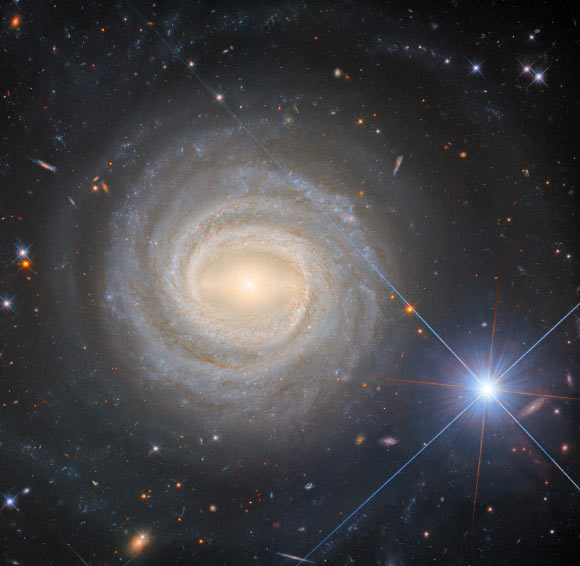Astronomers using the NASA/ESA Hubble Space Telescope have taken a picture of the bright barred spiral galaxy NGC 3783, which is found in the constellation of Centaurus.
This Hubble image shows NGC 3783, a barred spiral galaxy some 135 million light-years away in the constellation of Centaurus. The color image is composed of infrared and optical observations from Hubble’s Wide Field Camera 3 (WFC3). It is based on data obtained through five filters. The color results from assigning different hues to each monochromatic image associated with an individual filter. Image credit: NASA / ESA / Hubble / M.C. Bentz / D.J.V. Rosario.
NGC 3783 is located about 135 million light-years away in the constellation of Centaurus.
Otherwise known as ESO 378-14, LEDA 36101 or 2XMM J113901.7-374418, this galaxy was first discovered on April 21, 1835 by the English astronomer John Herschel.
NGC 3783 hosts a rapidly rotating black hole of 2.8 million solar masses.
It is a main member of the NGC 3783 galaxy group, a gathering of 47 galaxies.
“Like galaxy clusters, galaxy groups are aggregates of gravitationally bound galaxies,” the Hubble astronomers said.
“Galaxy groups, however, are less massive and contain fewer members than galaxy clusters do: where galaxy clusters can contain hundreds or even thousands of constituent galaxies, galaxy groups do not typically include more than 50.”
“The Milky Way is actually part of a galaxy group, known as the Local Group, which contains two other large galaxies (Andromeda and the Triangulum galaxy), as well as several dozen satellite and dwarf galaxies.”
“The NGC 3783 galaxy group, meanwhile, contains 47 galaxies,” they added.
“It also seems to be at a fairly early stage of its evolution, making it an interesting object of study.”
“Whilst the focus of this image is the spiral galaxy NGC 3783, the eye is equally drawn to the very bright object in the lower right part of this image. This is the star HD 101274,” the researchers said.
“The perspective in this image makes the star and the galaxy look like close companions, but this is an illusion.”
“HD 101274 lies only about 1,530 light-years from Earth, meaning it is about 85,000 times closer than NGC 3783.”
“This explains how a single star can appear to outshine an entire galaxy!”
According to the scientists, NGC 3783 is a Type I Seyfert galaxy — a galaxy with a bright central region.
“In this image it is recorded by Hubble in incredible detail, from its glowing central bar to its narrow, winding arms and the dust threaded through them, thanks to five separate images taken in different wavelengths of light,” they said.
“In fact, the galactic center is bright enough to Hubble that it exhibits diffraction spikes, normally only seen on stars such as HD 101274.”


